Relaxing eucalyptus showers (whereby you tie a bundle of fresh eucalyptus over your shower head) have become popular because they bring a bit of spa-like luxury into your everyday. Simply turn on the hot water and let the eucalyptus clear congestion and give you an energy boost. But if you can't get your hands on fresh eucalyptus, these eucalyptus bath bombs and shower steamers are the perfect substitute.
Simply place one in the corner of your shower or drop one into a warm bath. As they fizz, they'll release a hit of cooling eucalyptus essential oil into the air, immersing you in deep relaxation and curing whatever ails you.
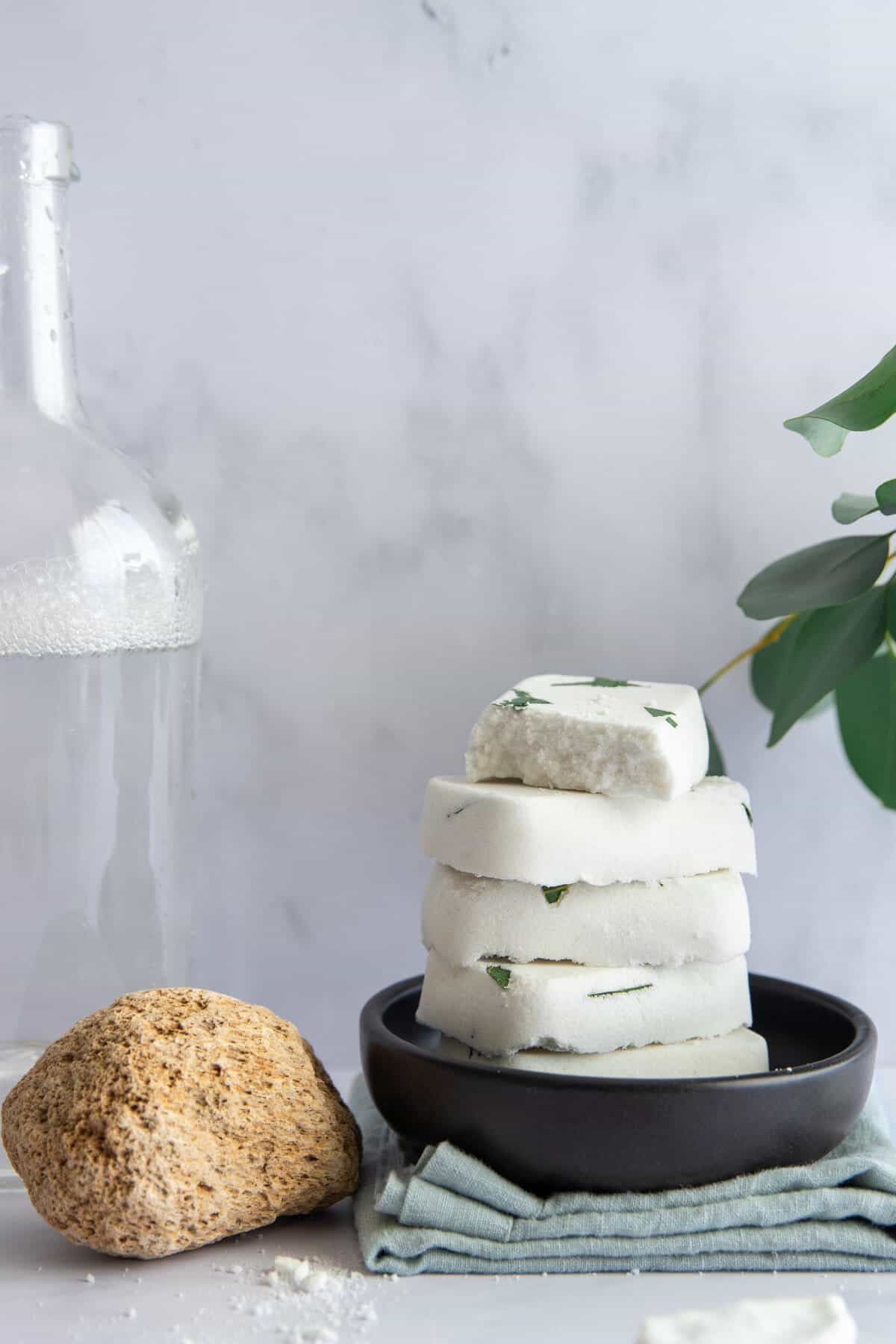
Hear me out: eucalyptus is the OG form of self-care. Do you remember getting slathered in chest rub when you were sick as a kid? While I can’t speak for everyone, chances are it was a common occurrence in your house growing up!
And it turns out, those days spent curled up in bed with a hot drink on my nightstand and the smell of eucalyptus wafting through the room—well, that’s exactly what my self-care looks like now, too. And if you'd like to enjoy self-care without the yucky part of being sick, these eucalyptus recipes are just the thing to make you feel better.
Jump to:
Benefits of Eucalyptus Essential Oil
Eucalyptus essential oil is extracted from the leaves of the eucalyptus tree, and it's known for its menthol scent. Next time you're feeling sick or need help relaxing after a long day, try using eucalyptus to:
Clear the Sinuses: Eucalyptus essential oil is widely recognized for its ability to soothe the respiratory tract. Inhaling eucalyptus vapors can help alleviate congestion, open up airways, and provide relief from symptoms associated with respiratory conditions, such as colds, sinusitis, and allergies [source].
Boost Your Mood: That spicy, minty aroma of eucalyptus is said to help boost your mood and promote mental clarity. It is often used in aromatherapy to reduce stress, fatigue, and mental exhaustion.
Promote Relaxation: Eucalyptus oil has calming properties that can help reduce stress and tension (my husband swears by it for soothing tension headaches). Inhaling its scent during aromatherapy sessions can promote relaxation and give you a sense of well-being.
Fight Germs and Viruses: Eucalyptus possesses natural antibacterial and antiviral properties, making it a popular choice for combating infections and boosting the immune system [source].
Relieve Pain: Inhaling eucalyptus essential oil for 30 minutes on three consecutive days has been shown to decrease pain associated with knee replacement surgery [source].
Ingredients
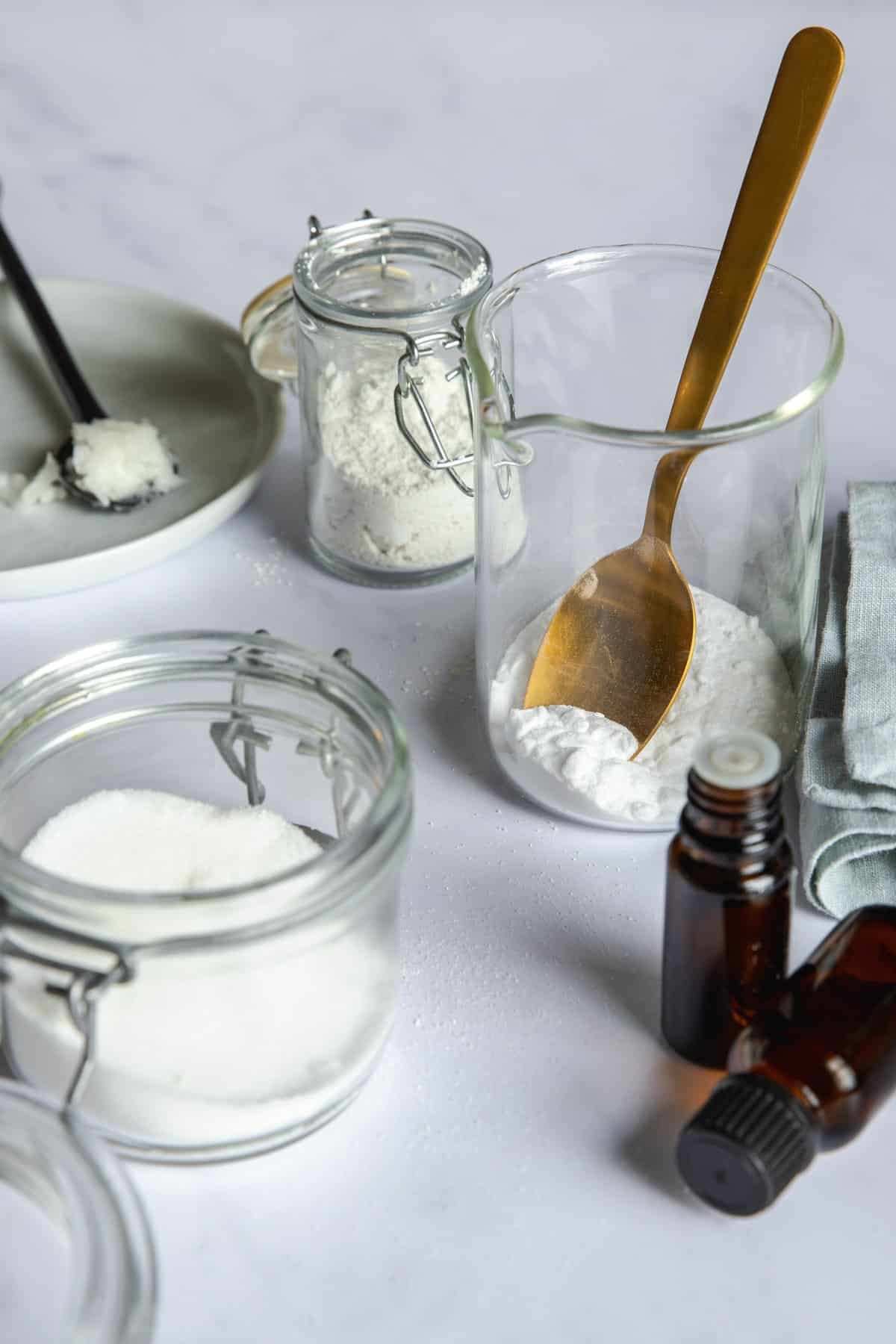
The ingredients in shower steamers and bath bombs are mostly the same. While we might vary the ingredients slightly so the recipes are a little bit different, you don't have to. Go ahead and use your eucalyptus bath bombs in the shower or your shower steamers in the bath—seriously, I won't tell.
Baking soda and citric acid are the key ingredients that provide fizziness to the bath bomb or shower steamer when it comes in contact with water.
White kaolin clay and Epsom salt are used for their skin-soothing and cleansing properties.
You can include more eucalyptus and other congestion essential oils in shower steamers since you'll only be inhaling the aroma in the shower, and the oils won't come into direct contact with the skin like with bath bombs.
Eucalyptus Shower Steamers
- 2 ½ cups baking soda
- 1 ¼ cups citric acid powder
- ½ cup kaolin clay
- 2 tablespoons water
- 1 teaspoon eucalyptus essential oil
- .5 teaspoons peppermint essential oil
- 40 drops rosemary essential oil
Eucalyptus Bath Bombs
- 3 ¾ cups baking soda
- 2 cups citric acid
- ¾ cup Epsom salt or sea salt
- 3 tablespoons coconut oil melted
- 30 drops eucalyptus essential oil
- 15 drops tea tree essential oil
- 15 drops cypress essential oil
Instructions
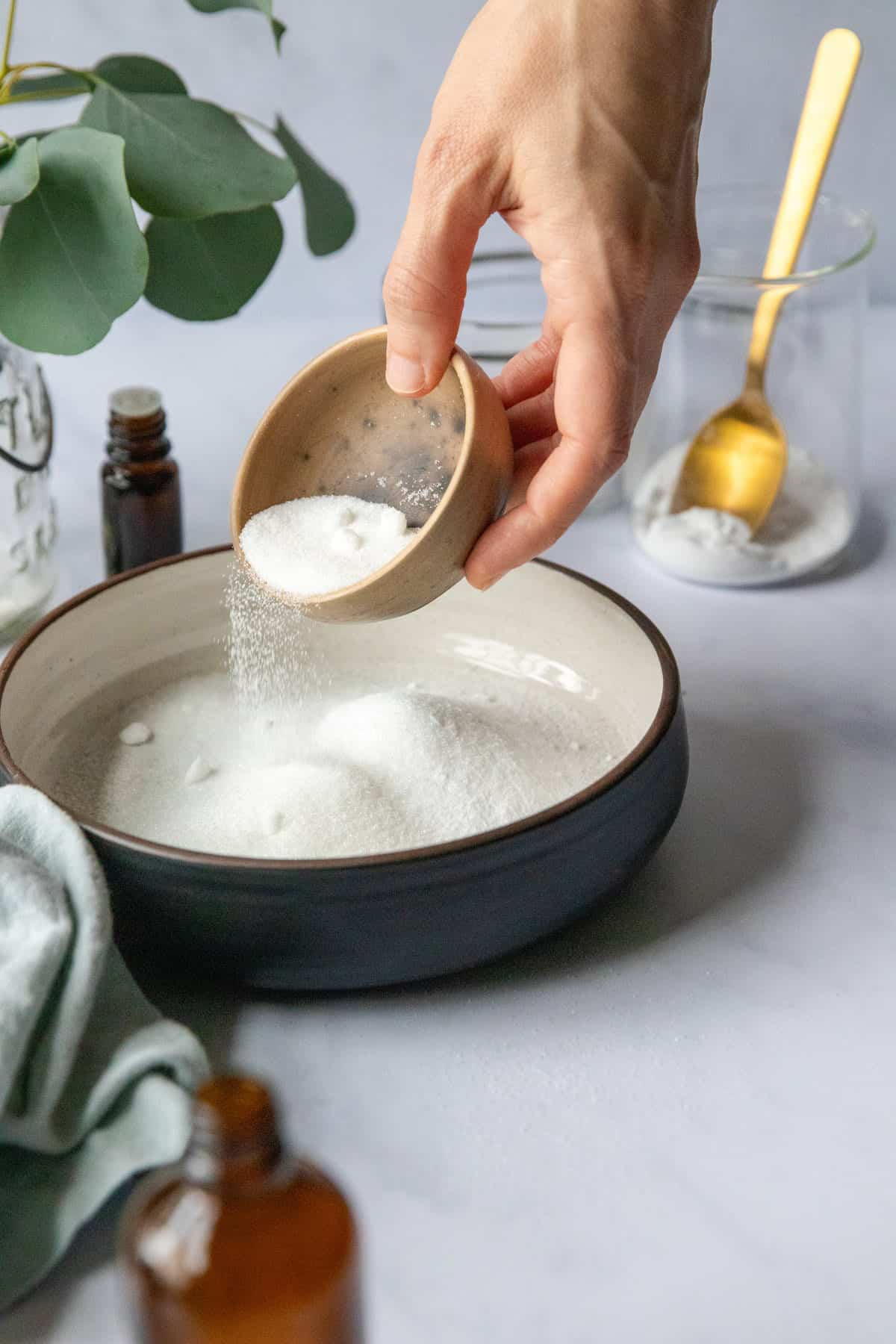
Step 1: Combine the Dry Ingredients
In a mixing bowl, combine the baking soda, citric acid, and any other dry ingredients, like Epsom salt or kaolin clay.
Use a whisk to mix the ingredients evenly and ensure there aren't any clumps.
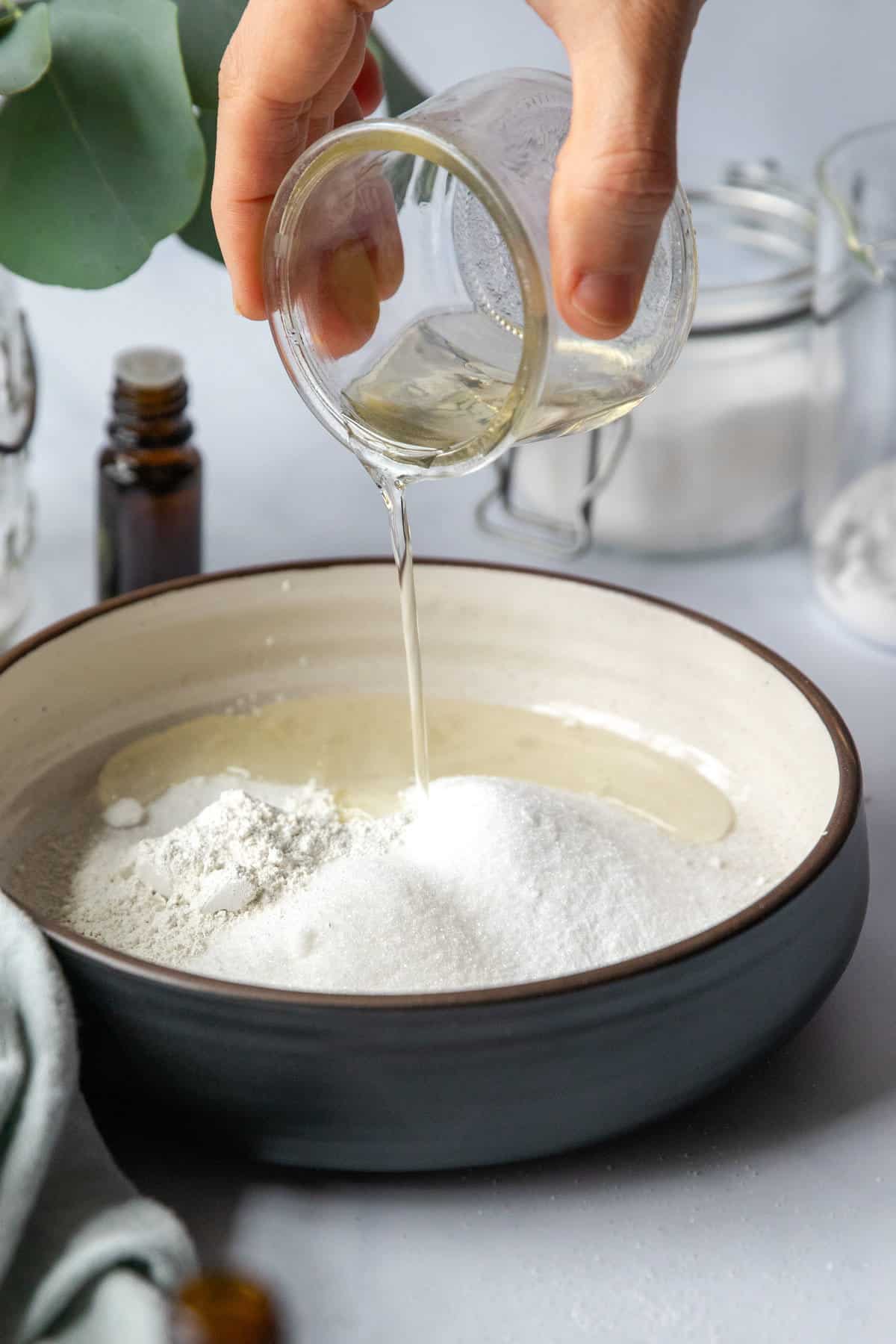
Step 2: Add the Wet Ingredients
Combine the essential oils with the coconut oil and stir. Then slowly incorporate the wet ingredients into the dry mixture. Use a whisk or your hands to combine the ingredients thoroughly. The mixture should have a consistency similar to wet sand and hold its shape when squeezed together.

Step 3: Add To Molds
Pack the mixture tightly into your molds. They should be compact to prevent crumbling when dry. You can use spherical molds or other shapes depending on your preference.
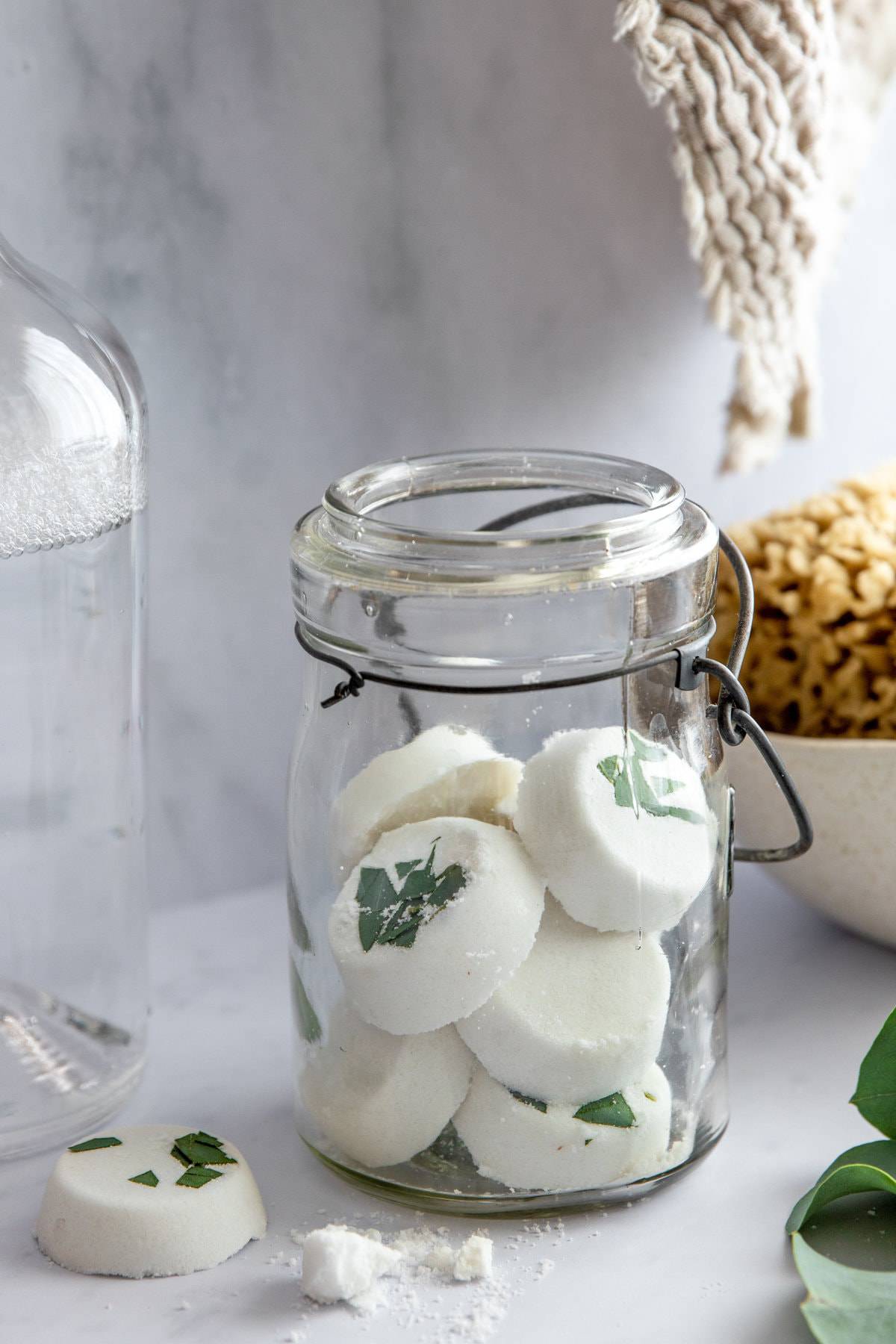
Step 4: Let Set + Dry
Allow the filled molds to dry and set at room temperature for at least 24 hours. When the bath bombs are completely dry and hardened remove them from the molds and store them in an airtight container until you're ready to use them.
Substitutions
Coconut Oil — You can leave out the oil and use a small amount of water or witch hazel to wet the ingredients. However, we use coconut oil to help bind the ingredients together and keep the bath bombs / shower steamers from falling apart.
Note that it will leave the floor feeling slick, so you'll need to be careful not to slip when getting in and out of the tub.
Eucalyptus essential oil — You can also try peppermint and tea tree oil if you need a little extra sinus-clearing power. Or lavender for relaxation, citrus oils like lemon or orange for mood-boosting, and calendula for its skin-soothing properties.
Storage
Store your eucalyptus bath bombs and shower steamers in an airtight container or a sealable bag to maintain their freshness. It's crucial to keep them in a cool, dry place to ensure that they're not exposed to moisture, which can cause them to lose their scent and fall apart or fizz prematurely.
When stored properly, should stay good for several months to a year. But always check for any changes in appearance, scent, or texture before using them, and throw them away if you notice any changes.
Eucalyptus Shower Steamer Variations

1. Menthol and Eucalyptus Shower Steamers
Follow the base ingredients from the eucalyptus shower steamer recipe but add an extra dose of congestion relief with menthol steamers.
- 50 drops eucalyptus essential oil
- 50 drops peppermint essential oil
- 1 teaspoon menthol crystals (dissolved in a small amount of boiling water)
Incorporate the menthol solution into the water before mixing it with the dry ingredients. Proceed as per the basic recipe.
2. Camphor and Lavender for Relaxation and Congestion
The combination of camphor and lavender essential oils in a shower steamer works effectively for both congestion relief and relaxation. Camphor is often used in medicinal chest rubs and balms to relieve respiratory congestion.
- 50 drops camphor essential oil
- 50 drops lavender essential oil
Mix essential oils with the water before combining with the dry mixture. Follow the same procedure as mentioned in the basic recipe.
3. Rosemary and Lemon for a Clear Head
Rosemary and lemon make a refreshing and invigorating combination. Rosemary helps clear the mind, while uplifting lemon boosts mood and energy levels. Try it in a morning shower to kickstart the day with clear sinuses and a sharp mind.
- 50 drops rosemary essential oil
- 50 drops lemon essential oil
Mix the essential oils with the water, then add to the dry ingredients. Proceed with the standard steps for mixing and molding.
Eucalyptus Bath Recipes for Congestion
Taking a eucalyptus bath can be a soothing and effective way to alleviate congestion. The steam from the bath enhances the inhalation of eucalyptus, making it easier to breathe in its decongestant vapors.
Here are recipes for eucalyptus bath salt, bath oil, and bath tea that you can try at home.
1. Eucalyptus Bath Salt
Aromatherapy bath salts are some of the easiest DIY recipes to make and use. This combination of Epsom salt and eucalyptus essential oil works effectively for congestion as the Epsom salt soothes sore muscles while eucalyptus' decongestant properties clear the nasal passages.
Ingredients:
- 2 cups Epsom salt
- ½ cup baking soda
- 2 tablespoon carrier oil
- 30 drops eucalyptus essential oil
- Optional: ¼ cup dried eucalyptus leaves for extra aroma
Instructions:
- In a large bowl, mix the Epsom salt and baking soda.
- Add the eucalyptus essential oil to the carrier oil and then combine the oil with the salt mixture and mix well.
- If using, stir in the dried eucalyptus leaves.
- Store the bath salt in an airtight container.
- Use 1 cup of bath salt per bath. Add it to warm bath water and stir to help dissolve the salts before soaking for 20-30 minutes.
2. Eucalyptus Bath Oil
Eucalyptus essential oil, which when mixed with a carrier oil and added to bathwater, creates a soothing experience that helps open up the airways and relieve congestion.
Ingredients:
- ½ cup carrier oil (such as coconut, almond, or jojoba oil)
- 30 drops eucalyptus essential oil
- Optional: 15 drops peppermint essential oil for an extra cooling effect
Instructions:
- In a glass bottle, combine the carrier oil with the eucalyptus (and peppermint, if using) essential oils.
- Shake well to mix the oils thoroughly.
- To use, add a few tablespoons of the oil blend to warm bath water. Swirl the water around with your hand to disperse the oil before soaking.
3. Eucalyptus Bath Tea
This bath tea recipe combines dried eucalyptus leaves with peppermint, chamomile, and rosemary, creating a potent herbal blend that, when steeped in hot bathwater, releases anti-inflammatory and decongestant compounds.
Ingredients:
- 1 cup dried eucalyptus leaves
- ½ cup dried peppermint leaves
- ¼ cup dried chamomile flowers
- ¼ cup dried rosemary leaves
- Large tea bags or a piece of cheesecloth and string
Instructions:
- Mix all the dried herbs in a bowl.
- Fill each tea bag or cut a piece of cheesecloth, add the herbal mixture, and tie it securely with a string.
- To use, hang the bath tea bag directly under the faucet while running a hot bath, allowing the water to flow through the herbs. Alternatively, you can let the tea bag soak in the bath as you would with a tea cup.
- Soak in the bath for 20-30 minutes, breathing in the vapors to help clear congestion.
Using Shower Steamers + Bath Bombs for Congestion
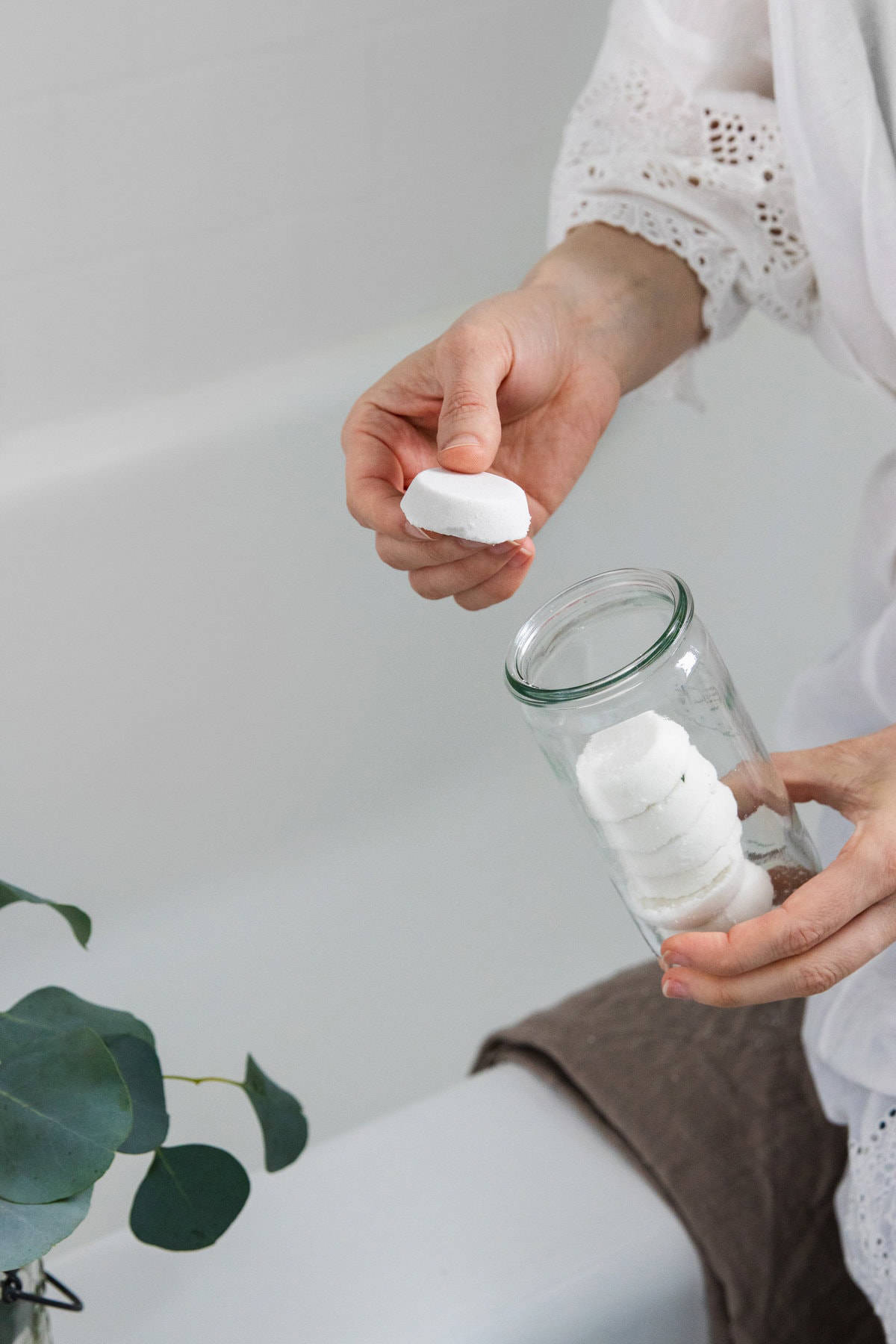
Using Bath Bombs
You'll get the most benefit from your bombs if you use them the right way. Place the bath bomb in the water after the tub is filled and allow it to fully dissolve before getting into the bath. This ensures that all the ingredients, including essential oils and skin-conditioning agents, are evenly distributed in the water.
Using Shower Steamers
Shower steamers are placed in the shower, and the steam from the water activates the essential oils, releasing aromatic vapors. You can get the aromatherapeutic experience without the need for a bath!
If using a shower steamer, place it in a corner of the shower where it will get wet but won't be rinsed away. Unlike bath bombs, you want shower steamer to dissolve slowly, so they can release their essential oils over time.
And yes, you can use your shower steamers in the bath in a pinch, however, they might not have the same fizzing or moisturizing properties as bath bombs.
FAQ
It depends on the ingredients. Bath bombs with gentle ingredients like kaolin clay and soothing essential oils may be suitable for sensitive skin, but it's advisable to test a bit of dissolved bath bomb on a small patch of skin first before climbing into the bathtub.
While they are designed for the shower, you're free to use shower steamers in a bath for a similar aromatic experience.
Most bath bombs won't stain unless they contain a colorant, such as turmeric or food coloring. Even if yours don't contain a colorant, it's best to clean the bathtub after each use to get rid of any potential residue.
Sure! Just keep in mind that breaking apart a bath bomb may affect its fizziness and overall performance.
Sinus Clearing Eucalyptus Bath Bombs and Shower Steamers
Equipment
- Mixing bowl
- whisk
- Silicone mold or ice cube tray
Materials
Shower Steamers
- 2 ½ cups baking soda
- 1 ¼ cups citric acid powder
- ½ cup kaolin clay
- 2 tablespoon water
- 1 teaspoon eucalyptus essential oil
- .5 teaspoon peppermint essential oil
- 40 drops rosemary essential oil
Bath Bombs
- 3 ¾ cups baking soda
- 2 cups citric acid
- ¾ cup Epsom salt or sea salt
- 3 tablespoon coconut oil melted
- 30 drops eucalyptus essential oil
- 15 drops tea tree essential oil
- 15 drops cypress essential oil
Instructions
- In a mixing bowl, combine the dry ingredients. Use a whisk to ensure that everything is evenly mixed and there aren't any clumps.
- Slowly pour the coconut oil into the dry mixture while constantly whisking. Ensure that the wet ingredients are evenly distributed throughout the dry mixture.
- Add the essential oils and whisk again.
- The mixture should resemble wet sand and hold its shape when squeezed together. If it's too dry, you can add a tiny bit more coconut oil and mix again.
- Firmly pack the mixture into silicone molds or an ice cube tray. Press down to ensure the mixture takes the shape of the mold.
- Allow the shower steamers to dry and set for about 6 hours. You can leave them at room temperature or place them in the refrigerator to speed up the process.
- Once completely dry and hardened, carefully remove the shower steamers from the molds. If you're having trouble, you can gently tap the mold or flex it to release the steamers.

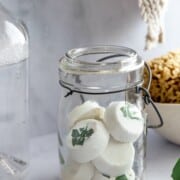



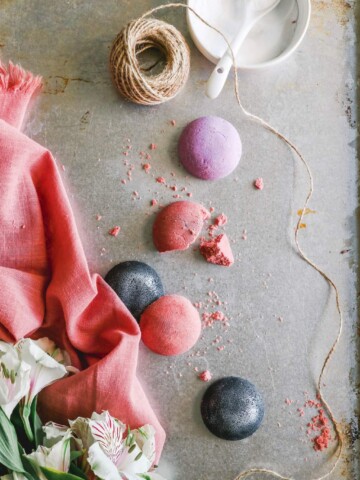
Leave a Comment